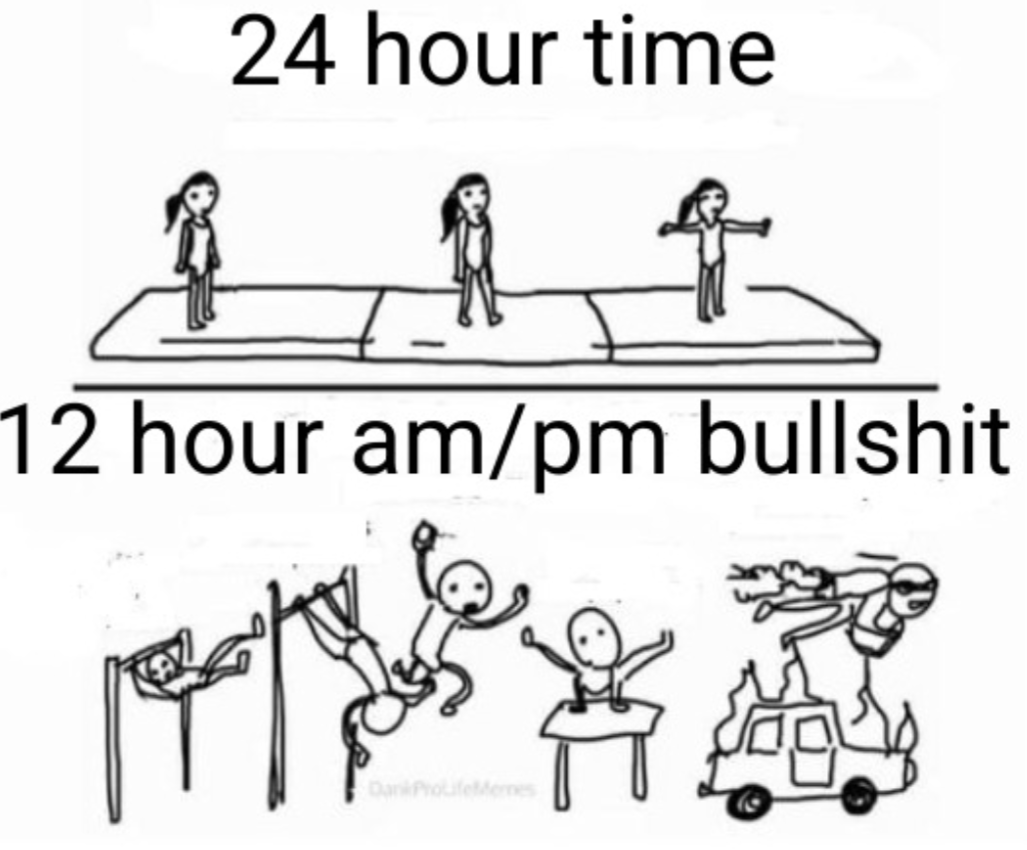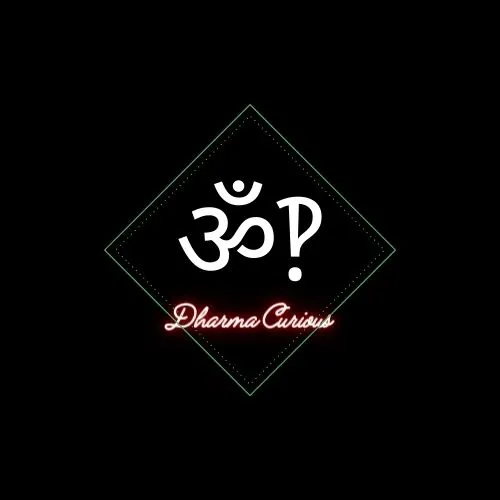The day starts at zero, not 12. 12 is “Noon” ie halfway through the day. The clock starts at 12 because it’s more practical than inscribing 24 divisions in a circle. And the 6 doesn’t “mean 30”, it’s simply the hour marking at the bottom of the circle. Finally, the 12 hour clock was invented after the 24 hour day, not the other way around.
And inb4 “I bet you’re fun at parties”. I’m all for “this logic is ridiculous” jabs, but this is just misrepresenting everything to make it sound stupid. Everything sounds stupid when you purposefully get it wrong.
Personally, I enjoy this kind of discussion at parties.
You sound fun at parties
I mean the day does start at “the 12” on the face of the clock. And 30 minutes is at the 6 on the clock. I get what you’re saying but come on they both make sense.
You must be fun at parties 😉 jk I’d party with you! I’m not very fun at parties tho.
Well to add some more pedantry to this conversation, only one of the explanations makes sense, the other is obtuse for comic effect.
Let’s all have an awful party together 🥳
In the US the day starts at 12 AM; there is no zero.
The most unlogical thing. If it starts at 12 AM, the next hour is 1 PM, right?
I prefer midnight and noon, or a 24h clock.The most unlogical thing. If it starts at 12 AM, the next hour is 1 PM, right?
No, ante meridiem and post meridiem say whether it’s before or after noon, thus, after 12:59 AM comes 1:00 AM.
https://en.m.wikipedia.org/wiki/12-hour_clock#Confusion_at_noon_and_midnight
I mean when looking at numbers:
. . . . . . 1100pm 1159pm 1200am 1259am 0100am … 1100am 1159am 1200pm 1259pm 0100pm … 230024h 235924h 000024h 005924h 010024h … 110024h 115924h 120024h 125924h 130024h … Too much confusion.
Even NIST (National Institute of Standards and Technology in the US) suggests:
To avoid ambiguity, specification of an event as occurring on a particular day at 11:59 p.m. or 12:01 a.m. is a good idea, especially legal documents such as contracts and insurance policies. Another option would be to use 24-hour clock, using the designation of 0000 to refer to midnight at the beginning of a given day (or date) and 2400 to designate the end of a given day (or date).
I didn’t want to imply that the use of the 12 hour system should be prefered in any way. Just that the division into AM and PM follows some logic. Its just the numbering 12, 1, 2,… that’s weird.
I like your reply. I think it’s a source of all problems.
“midnight” and “noon” for sure.
… And now I’m thinking about all those super heros and villains named “midnight” and their logical counter-characters “noon”
the 12 is a zero point, it’s just listed as 12.
You don’t know what a.m. and p.m. mean.
Let me introduce you to something known as military time (which, yes, even exists in the US)…
The clock is two dials at the same time superimposed on another. There’s one 12 hour dial and one 60 minute dial. To save space and material they are combined into one.
To akshually your akshually, the day DOES start at 12 in places that use a 12 hour clock, since midnight is 12am and there is no 0am.
Also this meme is not a serious criticism of clocks meant to be taken literally, so taking it as such so you can debunk it just makes it look like you’re trying too hard to appear smart.
to akshually your actually post, the 12 IS zero. noon, as in midday isn’t zero, which is a sort of arbitrary decision. That’s the differentiating feature between the two systems.
Technically i guess you could count the noon point as 0 also, but that provides ambiguity, so i think it;s better to treat noon as 12, and midnight as 00:00 (but listed as noon) because then it perfectly maps to 24hr time.
Also, noon is when you set your clocks based on the sun.
The clock starts at 12 and not 0 because humanity didn’t have the concept of 0 when we invented the 12 hour clock
12 is the zero point, it’s just indexed one off, because there isn’t a 00:00 timeslot in 12 hr time, so it needs to be 12.
It has to do with 24hr time being zero indexed, and 12hr time being 1 indexed, so it’s slightly offset at the point of day changeover.
You sound stupid when I purposefully get it wrong
Edit: dear Lord, y’all’s funny bones are broken tonight
Base 12 you filthy casual
Actually, they used base 60.
at least it isn’t base decimal
Every base is base 10 if you write it in its own base
yes that is why I specified decimal, I am a jan misali enjoyer
Love Jan misali, but I disagree with him that base 6 is preferable. Base 12 is best base.
Too much maths 🥴
This is [email protected].
This guy bases.
I’m from c/all and WTF does this mean? I understand base 10, 2, and 12 and the concept of a base in general but…wut???
The number 2 in base 2 is 1x2 + 0x1 and is written as 10.
The number 3 ib base 3 is 1x3 + 0x1 and is written as 10.
The number 7 in base 7 is 1x7 + 0x1 and is written as 10.
The number 268 in base 268 is 1x268 + 0x1 and is written as 10.
c/eli5
i got you, so basically, in a “base” system, each given “number position” or place value, as we call it holds the value equivalent to it’s base, so in base ten, the first position, holds 0-9, the second one holds 0-9 as well, but it’s tacked on the beginning of the last place value, so it’s an additive system.
In binary for example, 00 would be 0 in base 10. 01, would be 1 in b10, 10 would be 2 in b10, and 11 would be 3 in b10. This is because in binary, the first position is a value of 1, the second is 2, the third is 4, the fourth is 8, etc. It doubles everytime you add one more place value. So in binary you’re representing any given number, from the most mathematically optimal way to create that number, given a set of values. The 0 or 1 in that place just denotes whether or not that value is “present”
The same thing happens in base 10, or base 12, or base 8. With base 10 it’s just a lot more intuitive to us.
The joke here is that in base 268, that 10 in base 10, is actually a representation of the highest possible value, in any given base system. So technically in base 268, you would use 0-267 (im using base 10 here as a reference, this wouldn’t be done in base ten obviously, this is why i really like binary as an example, because it’s mathematically simple, and very intuitive to comprehend), and when you reach 268, you would roll over, and add an additional place value. Making it 10.
This is true for every base system, due to how base 10 is represented in those systems, it’s a confusing joke because the human brain is wired to think about it base 10, when it isn’t.
Oh I’m sorry, I’m an engineer and learned about bases in college. I was just saying how the above comment was pretty much exactly what I’d expect to see in a c/eli5 post! Super succinct
Oh boy, I am not sure I have the vocabulary to explain this effectively. But I will try!
Okay so normally when we say “base 10” or “base 2”, the number in that description is itself in base 10, right? Like the “10” in “base 10” means the number of fingers most humans have (including thumbs), and the “2” in “base 2” means the number of things in a pair.
You will note, though, that for that “10” to mean what it means, and that “2” to mean what it means, they must be in base 10 themselves. A pair of things in base 2 is 10 things, right? So then if you write the “2” in “base 2” in base 2, it’s “base 10”. And this holds true for any base. How do you write a dozen in base 12? 10. So base 12, written in base 12, is base 10.
Nailed it. This was a perfect explanation. Thank you!
There is an old unix calculator program called bc where one can change the input and output base.
If you change the input base and then the output base strange things happen as bc interprets the output base number in the input base .
ibase=2 obase=10 The output base is now 2 (in base 10)
Based
You fools need to submit to the 4 simultaneous separate 24 hour days within a 4-corner (as in a 4-corner classroom) rotation of Earth.

“There is no teacher on Earth qualified to teach Nature’s Harmonic Simultaneous 4- Day Rotating Time Cube Creation Principle, and therefore, there is no teacher on Earth worthy of being called a certified teacher.”
-Gene Ray, Visionary
1 day greenwich time is bastardly queer and dooms future youth and nature to a hell.
Classic Gene Ray
The time cube is simultaneously really funny and possibly the most bigoted thing I’ve ever read. Like holy hell this guy is more antisemitic than some neonazis and his hate for queer people is intense. Shockingly not misogynistic though, credit where credit is due.
I thought above was just some sort of surrealist joke. Then you informed me that this is an actual thing. I have never been milkshake ducked this abruptly.
Oh it’s absolutely not a joke. It reads like severe mental illness. It’s very much an uneducated white southern man lost his fucking marbles. He’s so antisemitic he hates Christianity.
Like you read it and at parts you’re laughing and screenshotting and at other parts you’re agahst. Like this is a perfect line

But he’s also saying things about black people that make my assessment of mentally ill southerner make sense. I went in for cheap yuks at something I was shown as a teenager because it was funny and left too uncomfortable to recommend it to anyone.
lost his fucking marbles.
Funny thing about that. He was an avid promoter of the game of marbles and wrote a book called “Marbles for Everyone” under the name “Mr. Marbles.”
But yes, also a raving lunatic until he died in 2015.

Based on his other writing I highly doubt that he meant everyone lol. And yeah I had to double check that you weren’t lying lol
But yeah looking back at it, it really is a mentally unwell man attempting to comprehend the reality that everything is sinusoids as he hates circles
That was the south when I was young, but it was fairly sparse.
Social.media is like typhoid Mary.
TimeCube is legit internet lore at this point. One of the earliest viral meme sites I can remember… as in a site that was meant to be taken seriously, but so absurd it became a meme.
I have not though about the time cube in years, looks like the site is gone now.
He passed almost ten years ago I think, the domain lapsed. Pretty sure it’s archived on the way back machine.

Reminds me of the collective confusion in english class when they taught us that 12:15 am is in the night and 12:15 pm is at lunchtime.
Imo anyone using 12:XX am for midnight for the sake of “symmetry” with 12:XX pm or whatever is adding pointless complications on top of the already pointless am/pm system. Midnight has no reason to not be 00:XX am in that system
It ain’t about symmetry or pointless complications. It’s about how many numbers can you get on a watch face and have it be easily legible. Yes, I know there are digital watches these days. But some people don’t like them and some of us need those analog faces. As an old medic, digital watches absolutely suck at timing things like BP or respiration’s. Neither me or my patient had time for that digital watch to zero so I could get a BP in 15 seconds. Ten’s of thousands of EMS people and nurses in general are wearing 12 our analog watches around the world right now.
Now my run reports were all done n 24 hour time because the little boxes on those paper run reports were tiny and often filled out in a hurry. So 24 hour time was more legible and clear to anyone reading the report.
Besides, can you not look out a window to see if the sun is up or not? That will tell you all you need to know to understand how to use 12 hour time.
Its not about understanding it. Its about using it. I cannot tell you the number of times I had set an alarm 12 hours off before switching to 24 hour time. After I switched it never happened again.
Besides 24 is divisible by 12 so you can just double up the numbers on an analog clock. I have an analog watch with 24 hour face that looks similar to this:

Idk, I get your arguments but I’ve seen quite a lot of beautiful watch faces with small 24 hours numbers under the 12 hours one. Of course it works best with the big ones, but that seems to be in fashion these days.
I have no inherent issues with using or understanding 12 hours time, I just think it is actually adding complexity to something that is already pretty much perfect, for reasons that are mostly cultural nowadays (you’ve gotta admit that your point about hospital workers, while very valid, is still kinda isolated. Plus when I was wearing my watch with a 12 hours face daily I just did the x2 multiplication in my head).
Also there’s a reason basically all militaries use 24 hours, and I don’t think it’s because they think highly of their average soldier’s intellect.Besides, can you not look out a window to see if the sun is up or not? That will tell you all you need to know to understand how to use 12 hour time.
That reminds me how after not sleeping for 3 days (I studied for an exam) I fell asleep randomly on my bed (more like passed out) and woke up to a low sun, the analog clock showing like 7:00, and I could not tell whether the sun was rising or setting.
(As a side note: I didn’t have a clue whether my window went out to the west, east, north, etc, and I was way too groggy to even think like that. It was more the color of the light in the room that was ambivalent. Obviously I checked my phone rather quickly and didn’t need to figure out the position of the sun to understand whether it was morning or evening)
Just remember that m is midday, when the sun it high in the sky. Anything with an a is before that moment, everything with a p is after that. It’s not that hard. Now, making heads or tails of thumbs, feet and miles. That’s a head scratcher.
I’m not saying it’s hard, and we got the explanation too. It’s about what feels or seems off. It’s technically correct, I know, but the first reaction of the class was confusion and a lack of intuitive understanding. Mostly it is using 12 instead of 0.
It seems off if you look at it from a purely numerical point of view. If you tackle it from a geometric POV and the face of a clock, it makes sense. That time representation was meant to be cyclical, not lineal. Time is a circle, not a vector.
I see what you mean and where you’re coming from, and I also realize there are historical reasons for 12 hours, there’s a reason it’s called "p"m and "a"m and so on. Still, it does not feel intuitive to jump from 11:59 am to 12:00 pm, go on to 12:15 pm, and end up at 1:00 pm again. It feels like an either or thing. Either you go to 12:00 am after 11:59 am, or you go to 0:00 pm. I understand why it is pm and why it is 12, I am just saying, it feels off to me (and, as mentioned above, the whole class of German students). I absolutely understand that it feels much more natural and less counterintuitive if you have grown up with this system.
For an analog clock the reason for 12 hour time is that twelve divides evenly into 60 and 24 does not. Get rid of the whole 60 min/hour and 60 sec/min that make dividing a clock dial into 60 segments extremely useful and then we can talk about why there are twelve hours on it.
Actually that is not funny to make fun of thing you don’t understand.
A clock is a marvel using a plan to represent both numerically and in volume the time passing in an infinitly précise manner as it is continuous. Human reading precision can be chose at the level of the hour, the minute of the second. The 12-base allow a reading of the twelveths of the time period, the thirds, the halves and the quarters. The use of a circle make it possible to use it as a chronometer at any given start and follow the passing of time as your society see it.
That is just the data representation part!
The clock is also a marvel of ingeneering in the backend with very complex mecanism giving it a excellent precision and the abillity to run on many many different type of power.
the most impressive thing to me is that people managed to standardize and zero in a precise “second” especially back when seconds were kept by mechanical means. I wonder how they went about ensuring it.
A 1m pendulum has a 1 second half-period.
is it not dependent on mass at all? It’s possible given that this is the metric system that this is actually just a convenient retroactive truth about meters. I suppose it wouldn’t necessarily be, but then you’re accounting for gravity as well, which means you’re going to need a pretty effective approximation there. As well as a way to account for any mechanical losses as well.
I’m not sure the metric system even existed when we developed the first mechanical time keeping devices.
The mass cancels out.
I don’t know if it’s purely a coincidence. The meter comes from the Earth’s circumference (1/10 000 000 of the pole-equator distance) and I believe the second is much older, which points to a coincidence.
it makes sense that the mass does cancel out, it is a change of potential and kinetic energy at all, i suppose i’m just conflating more complicated things with it lol.
it’s pretty likely to be a coincidence, but if i had to guess it’s a “lucky coincidence” one that was intentionally chosen because of it’s convenience. Rather than by pure happenstance. There’s not a particularly good reason 1 meter needs to be 1/10000000 the pole equator distance for example. So that would be pretty easy to reverse fudge nicely.
So I did some digging and the use of 1-second pendulum as a unit of length predates the metre by about a century. It’s very possible it informed the choice of ratio to use when defining it properly, like we did with the recent definition change.
It’s all on Wikipedia if you want to dive in yourself.
that sounds about right. About what i expected, i’ll have to do some reading sometime i suppose.
At least that’s an useful approximation, but too inprecise for accurate measurements over an entire day.
It’s only 0.3% off. You probably have more uncertainty on the length of the pendulum.
0.3 % would correspond to 3 mm difference in length of the pendulum.
After an hour, the difference between real and measured time would already be 10.9 s, and over an entire day, it would accumulate to 261.3 s, way too much for useful long term measurements.
Yet, it is an useful approximation for qualitative measurements, e.g. when Galileo Galilei did his fall experiments, he might have used a prendulum instead of his pulse for measuring.I’m not hauling this as the ultimate time keeping method. Friction in the system will mean you need to readjust it anyways. It’s just a neat fact that pi^2 ~= g
Atomic measurments, it’s why atomic clocks are the most accurate.
that’s a recent invention though, the first mechanical time keeping devices are what’s interesting to me.
The atoms are the powerhouse of the clock.
deleted by creator
Should watch an old BBC miniseries, Longitude.
So much fun watching how crazy clocks are engjneered, and Jeremy irons.
Thank you. I add it on the list (^_^)
I was fascinated by some of the crazy things people tried to get working that were discussed on that show. Things like keeping a pair of dogs, wounded by the same knife, as a way to synchronize time. As if they were some kind of quantum entangled particles.
Edit: Found it!
The powder was also applied to solve the longitude problem in the suggestion of an anonymous pamphlet of 1687 entitled Curious Enquiries. The pamphlet theorised that a wounded dog could be put aboard a ship, with the knife used to injure the dog left in the trust of a timekeeper on shore, who would then dip said knife into the powder at a predetermined time and cause the creature to yelp, thus giving the captain of the ship an accurate knowledge of the time.
Oh God… Weren’t this people happy water clock and other sandglass-like engine?
Is this from Timecube?
No it is from good sense and observations of technology inherited of extremly ancient civilisations.
The day starts at zero, the only way that makes sense.
And that’s why the way that am/pm is indicated is fucking lunatic.
I grew up with a 24h clock and I still mix-up 12AM and 12PM.
I don’t strictly mix them up anymore. But the confusing part is to switch from pm to am at midnight, but still use 12 instead of 0. Which day is it then?? The same day according to “12”, but the next day according to “am”.
And so you’re going 11pm -> 12am -> 1am. That’s the part that has never made sense, and never will.
Yeah, we should have just replaced the 12 on the clock with a 0 long ago.
And that’s if we aren’t going to take the “should” to its logical conclusion and just go with 24 hour and/or military-style time.
but then it would be even weirder, what you should really do is shift forward, so instead of it being 1-12, it’s 0-11, so it would be 0 at the very top, wrap around all the way to eleven, and then bump back to zero, where it would be inline with 24hr time sort of.
The other option is to standardize 24hr time off of the zero, so it actually has the 24 hour period. not 23, plus 0, which is still 24.
so it would be 0 at the very top
Yeah that’s exactly what I meant too, with replacing the 12 with a 0. Then as the clock swept past the top it would be 11:58, 11:59, 0:00, 0:01, etc.
It’s also funny that we’re talking about the “top” of an old analog clock, because with the digital clocks we all use on our devices now using 12 instead of 0 makes even LESS sense!
I believe the military-style time I mentioned is also 0-based 24 hours like you suggested. They leave out the extra punctuation and go from 0000 to 2359 iirc.
But the goofy 12 clock is probably here to stay for a long time just because people are used to it. I live in the US and am a native English speaker, so I’m used to special exceptions and unique measurement units. 😆
And I just noticed: pretty great username + post combo with this one!
12 should be noon and 0 midnight.
Post and ante meridiem translate to after and before midday.
it’s not zero because you don’t start at zero, you start at 12, it’s an offset. With a 24 hour system the hour 24 doesn’t actually exist, it’s 00:00-23:00 that’s it, with 12 hour clocks it’s 1-12, twice.
It’s just a shifting of where the scale starts, that’s why it confuses you, because you don’t think about it that way.
I know it’s not zero and that’s where the offset is, but my point is it ought to be zero and there shouldn’t be any offset. A scale doesn’t start at 12, numbers have a meaning.
Using zero makes far more sense not just in how am/pm is indicated, but in how we actually think about time. Nobody considers 00:45 = 12:45am as part of the previous day since it’s clearly after midnight. Using 12am is just an outdated convention established by people who counted hours only on a per-day basis and to whom the concept of a “zeroth hour” seemed irrational.
While I agree it is strange, I cannot ever seeing this be a problem. I have never meet someone that has ever had an issue understanding how a clock works. Maybe you were taught late?
I was taught reading clocks very early, in a mixed digital/analog setting, with the digital clocks using 24h format starting at 00:00, and nobody using am/pm. You should know that “12am” is not “how a clock works” universally, just one way of reading it.
I need to think of it as 12:10 am or 12:10 pm to orient myself… is the 12:10 at night? Then midnight is actually 12:00am since it doesn’t go 12:00pm to 12:01am.
Try 24-hour time for a month. It’s slightly weird at first solely because 1) everyone else uses 12-hour and 2) you’ve used 12-hour your whole life, but after that it’s great and frankly better than what you use now. Translations between 12-hour time become 100% automatic, so you can use it in your personal life without feeling like you’re switching (you might even get one or two friends to join you). The following are advantages just for you, not accounting for the larger advantages that come when everyone is using it:
- You can drop the AM and PM on digital clocks with no loss of information. It’s a small thing, but this gives me room for a seconds position on the clock on my taskbar. (Side note: given 8 billion people on Earth and given how often time shows up, I feel like these trillions of miniscule savings getting rid of AM and PM might add up to something actually meaningful.)
- You’ll never have that experience where you oversleep during a nap so badly that you get confused if it’s AM or PM.
- Most intervals we usually talk about for things (e.g. “I have school from 6:00 AM to 2:00 PM” or “I have work from 9:00 AM to 5:00 PM.”) do not include midnight in their range (e.g. “I slept from 9:00 PM until 6:30 AM”). Thus, arithmetic is easier because you don’t have to account for the modulus (at worst in the latter example, it’s the same). For example, when I go to school from 06:00 to 14:00, that’s just 8 hours. When I work a 09:00 to 17:00, that’s 8 hours. It’s just the actual arithmetic. It’s currently 10:00 and the assignment is due at midnight? Then I have 14 hours left to get it done. Whereas for 12-hour time, I need to account for the modulus: “okay, there’s x hours on this side of the 12 hours and y hours on this other side; add those” is how I probably do it in my head. Subtracting times is especially nice. For example, if something has been happening since 00:30 and it’s now 13:45, then I just need to subtract 30 minutes from 45 and I immediately have my answer. 1:45 minus 12:45, meanwhile? Nah. This also makes timezones much easier to do mentally. If I have +14 for my time and it’s 06:00, then I know it’s 20:00 there. Trivial. You do lose that sweet spot where something is exactly 12 hours apart, but that’s miniscule compared to how easy everything else is.
- Starting at 00:00 for midnight instead of 12:00 is just so much nicer. 12-hour time has no 0, which to me is just kind of stupid. Namely for aesthetic, intuition, and arithmetic reasons.
- If speaking to someone internationally, intuitively knowing both formats means you don’t even need to think about a conversion (let alone do one at all once you really get it down). Lots of countries use 24-hour time orally and written, and even more use it just in writing.
- Date and time formats use 24-hour rather than 12-hour time, so you can read these automatically instead of needing to convert.
- This one’s very unobjective, but I feel like I’ve been less inclined to go to bed late when dealing with larger numbers. “Oh, it’s just nine” versus now the 20s are “late” and when I really need to start thinking about how and when I’m going to bed. Obviously it’s possible this is just my monkey brain being weird in a specific way and that nobody else would have this, so pay attention to the other reasons instead.
- (Not beneficial to an individual using it on their own as an adult, but I wanted to bring it up.) It’s arguably slightly easier for kids to learn. Kids aren’t up at midnight, and so they don’t really have to care about the clock rolling over while they’re fast asleep (if they do, they get the much more intuitive ‘0’ than ‘12’). On the other hand, the clock rolling over at noon means you as a kid really do need to understand how that works.
It’s just objectively better in most meaningful ways, and like the metric system:
- Its benefits are most evident if you grew up with it and everyone around you uses it.
- Its benefits would still be evident if everyone switched to it but hadn’t grown up with it.
- Even if you didn’t grow up with it and no one else around you uses it, it can still benefit you to use it.
deleted by creator
As is so often the case, wikipedia has a helpful map https://en.wikipedia.org/wiki/24-hour_clock#/media/File:12_24_Hours_World_Map.svg
For all of exclusively 12 hour, exclusively 24 hour, 24 hour in writing but 12 hour in speech, and just using both at random, there are entire regions of the world using that system
I think it’s a US thing.
I use 12h clock when context provides the am/ap variation, 24h otherwise. I have had americans tell me I sound militaristic when I tell them my flight lands at "seventeen fifteen ". I guess they are right, the NATO format for time uses 24h clock.
Haha
Remember me when you learn this about the metric system
Is there a lemmy community devoted to the superiority of 24-hour time yet?
It’s interesting how different people process time. For some, pure numbers make sense, and adjusting to 24-hour time is a trivial matter. But for others such as myself, who came to understand time on analog clocks, we understand time visually, especially by the angles on a clock face.
It’s intuitive to me to “do math” on time by imagining what the angles of the hands would look like in two (or more) instances. If I need to get up by X time, I can glance at a clock and immediately know I need to go to bed by Y in order to get 8 hours of sleep, just by comparing where the clock hands would be in the morning. I rarely have to actually calculate anything, and even when converting between time zones, having an analog clock base means just counting the difference around the circle. Using a digital clock, by contrast, means having to visually interpret those numbers as they would be represented by clock hands. Those clock hand angles represent “the time” to me in a way that numbers on a digital display cannot. I understand 24 hour time, I’ve even used it professionally. But considering that it requires multiple conversions to arrive at the format (visual angles) that my brain uses to understand time, it’s far too much work for me, personally, to use in daily life.
I’m not advocating for or against any particular system, and I hope that others can benefit from the switch you suggest. I just think it’s important to note that some of us have a visual concept of time, and/or don’t easily abstract time onto pure numbers, and that difference can make switching from an analog 12-hour system to a digital 24-hour system more difficult.
I switched to 24 hour time because I work over night and have an inconsistant sleep schedule. It makes it easier to determine how much sleep I got and the exact time of day when waking up.
ever think about how 5 is 1/12th of 60? that means putting 5 min and 1h on top of each other is genius imo. because there are 12 times more minutes in an hour then there are hours in a day
there are 12 times more minutes in an hour then there are hours in a day
24 x 12 is 60? You are a weird mathematician.
yeahur right i meant to to say there are 5 yimes more minutes in an hour then there are hours in half a day xD
The clock evolved out of the sundial. 12 hours on the clock makes more sense if you think of it that way.
12/24 hours come from the idea that there are 12 day hours and 12 night hours. Historically most clock systems counted hours since sunrise. Counting since midnight is a recent change.
Where the 12 comes from? No idea. That’s a decision that was made several thousands years ago. It could be from some smart counting of fingers, joints, etc. It could come from the fact that 12 has a lot of dividers. It could be religious reasons (zodiac has 12 animals). Honestly no idea.
12 has more divisibles than 10.
12, 6, 4, 3, 2, 1
10, 5, 2, 1
Some suspect 12 was picked because you can more easily divide up into more useful time chunks.
Edit: you wrote this in your comment and I missed it somehow.
Then why don’t we use a base 12 counting system instead?
We used to. It’s called a dozen
That’s not really base 12, it’s just a special name for the decimal number 12.
It is now, but it used to be part of a base 12 system. 12 is a dozen, a dozen dozen is a gross, and dozen gross is a great gross.
There was some rough times as it switched to decimal and you wind up with bullshit like the ‘long hundred’ being 10 dozen and a short hundred being 10 tens.
Fair enough.
I was going to bemoan not having a special character for 11 and 12 but I guess people weren’t writing things down so much in the 1500’s and maybe there were characters for those numbers.
I wonder if that’s why we name 11 eleven and 12 twelve rather than firsteen and seconteen.
Nah, eleven and twelve not having a -teen suffix is because English doesn’t have any standards and steals language randomly. Both are germanic in origin, but different time periods. Eleven and twelve come from a 12th century system of counting on your fingers (twelve basically means ‘two left’ after you count to ten), and -teen is from a 14th century math perspective (thirteen basically means ‘ten more than three’).
It really is like that. Some people used to count with their fingers differently than we do now. They counted with the thumb on one hand, with each finger beginning (i.e. where the finger is connected to the hand) and each knuckle having a value. In total, with four fingers you get 4x3=12, which is where the expression ‘a dozen’ comes from. The other hand was used to count how many times you did this; strangely enough, with the fingers as we know them. So you could count up to 60.
At least that’s how I learnt it at some point. If anyone has more information on this, please let us know!
Incidentally, I find the binary counting method with the fingers more interesting, where you can count up to 1023 with ten fingers.
Huh, that actually makes some sense. How would it be written, I guess spoken you could easily go “eleven dozen and seven”, presumably you would need another symbol for 10/11. Write it as B7 if you wanted to use A/B similar to how you would use A-F with hexadecimal.
Probably take some time to get used to it from being used to using decimal.
probably the way we used to do it before we got arabic numerals, with knuckle counts and long hundreds
The “eleven dozen and seven” is functionally no different from “One hundred and thirty-nine.” We’d just have 2 more characters than we do now.
We even have a name for a third digit in base-12. 12 dozen is a “gross”.
The Babylonians used base 60, which is neat because it cleanly divides by 2, 3, 4, 5, 6, 10, 12, 15, 20, and 30, whereas base 10 has just 2 and 5.
Yeah but who’s got the taller tower?? Checkmate Babylonians
it depends on whether or not “eleven” would be base ten 11, or base 12 eleven.
Dozens, but not tens of something. I like English.
you can say tens of something, i don’t see an issue with that grammatically speaking.
“tens of thousands” literally derives from that phrasing even. similar to other weird anomalies like “ten hundred” which likely comes from “ten hundreds” for example
Technically speaking, any sort of arbitrarily defined grouping used in any numeral system can be used like this. For example 2^n would be relevant when discussing binary counting. You might refer to binary number groups as powers as a result.
I think some cultures used it. We use the base 10 mainly because of our 10 fingers but if you start counting with 0 (counting the closed fist) you could easily count to 12 with your hands as well.
Base 12 or base 8 would make me so happy.
But if could be worse. Imagine a universe where some idiot established base 7 or base 13.
Base prime sounds kinda cool though
True. It does sound cool for the same reason it would be a total nightmare to use.
A base prime would quiet my OCD 😓
It gets triggered by divisors?
I almost would have expected the opposite. Though I get that you can’t control it in any way.
For all the sense it makes… If it can be divided into a non prime. it is bad. Bad time, bad day, bad week, bad month, bad year… If I’m anxious it’s temperature and number of steps I took to arrive at my last destination
im convinced that base 8, or octal, as it’s known in cs was developed specifically for the purposes of computationally derived terrorism.
Just use binary, it’s better. If you really care, just use hex.
US length measurements…
The US didn’t exist when these choices were made
we do, it’s literally the imperial system.
If you want a real answer, it’s probably to do with arabic numerals being a base ten system, then being adopted globally, after the standardization of a base 12 in isolation for something like time. Arabic numerals specifically probably resulting from us often having 10 fingers, so it’s a natively intuitive system from that aspect. Though representing numbers from other systems (like base 12) in systems like base 10, isn’t hard, so most often, we just don’t really think of them existing in base 12 (like time does) since we think in base 10 most of the time.
Ask someone who has dealt with the binary system about this, and they will tell you the exact same thing. Even people experienced with binary counting logic still natively translate it to base 10 because it’s more intuitive that way. It’s one of the reasons that the doubling of possibilities every additional bit is a relevant discussion. Technically in the frame of binary, you’re just adding one more place value, however due to how binary works, and how base 10 works, it’s a rather disconnected counting system (base 10 has a lot more redundant uses of numbers, binary is mathematically perfect)
It’s the same reason why different parts of the world speak different languages with different grammar rules, shit’s weird, and sometimes it doesnt get adopted logically.
Historically double length hours also existed: 6 hours for daytime and 6 hours for nighttime.
One can’t rule out the convenient dividers argument but I think that can’t be the only reason.
The Babylonian calendar and relation between time and distance is incredibly interesting
https://en.wikipedia.org/wiki/Babylonian_calendar

I heard they do it that way because they count using their thumb and their finger joints, instead of their individual fingers.
The twelve comes from the babylonians, which counted the segments of four fingers with their thumb. So each hand could count to 12, which is far more useful than 10 as a base, since it can be divided by {1,2,3,4,6}.
It kind of checks out that the people that made the first fully functional writing system were also the kind of massive nerds (complimentary) to do their maths in base 60
Still doesn’t explain why the clock goes from 1 to 12, and not 0 to 11.
It does. 0-11 and 1-12 contain the same (12) amount of hours. Saying “twelve thirty two” just rolls off the tongue easier than “zero thirty two” or “o thirty two”.
Not to mention zero is a much later invention than the sexagesimal system.
Also here’s a clock with zero on it.

here’s a clock with zero on it
I like this clock very much and want one in my home.
Yes except why is no single digit except for 0 zero-padded?
Okay, now this clock is [email protected]
Also 12 can be divided by many factors (1;2;3;4;6;12) where as 11 is a prime number.
“The day starts at night” sounds silly because it seems to be a contradiction. But really, how else could it be?
Either, day starts at day … but then it was already day. Or, day starts at night … unless we come up with additional entities like dusk or dawn.
And since we haven’t introduced them yet, day has to start at night, as a necessity.
Of course the actual silly thing is that it’s still night right after day has started.
The silly thing about this joke in the OP is that day means both “when the sun is up/the opposite of night” and “a period of 24 hours”. English has a lot more words than my native language of Norwegian, but in this case we actually have separate words for the two aforementioned things.
What are the words?
Døgn vs dag
starts at midnight?
deleted by creator
Citation needed.
More like second means a second division of hour.
deleted by creator

















